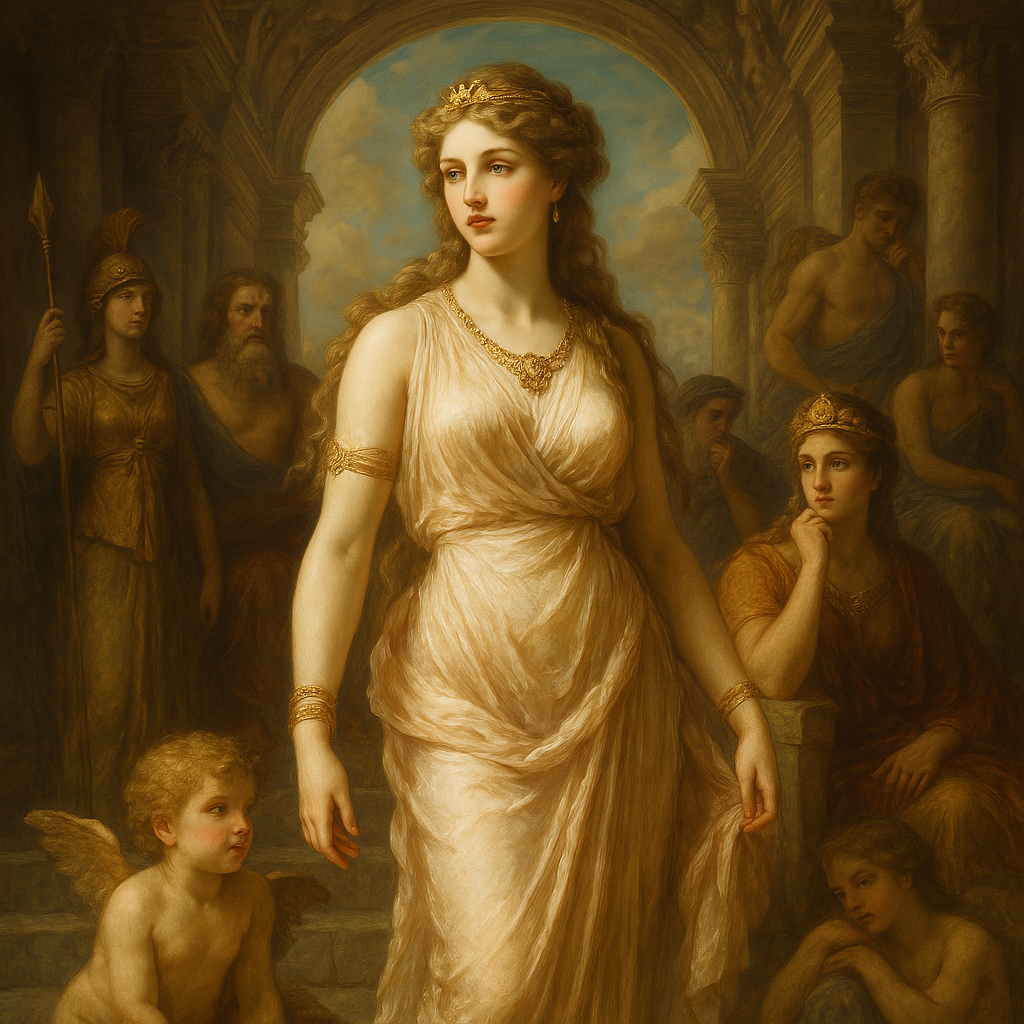Overview
Aphrodite is the ancient Greek goddess of love, beauty, desire, fertility, and sensuality. She personifies the irresistible force of attraction that binds all beings together—whether romantic, erotic, or creative. Revered for her enchanting charm and divine allure, Aphrodite plays a central role in countless myths, embodying both the gentler and more tumultuous aspects of love. Her Roman counterpart is Venus, and her legacy continues to influence art, poetry, and spiritual symbolism across cultures.
Origins and Mythology
There are two main origin stories for Aphrodite in Greek mythology:
- Hesiod’s Theogony: Aphrodite is born from the sea foam (aphros) after Cronus castrates Uranus and casts his severed genitals into the ocean. She arises from the waters fully formed near the island of Cythera, later floating to Cyprus, where she is embraced as a goddess.
- Homer’s Iliad: Described as the daughter of Zeus and the Titaness Dione, suggesting a more Olympian lineage.
Despite the differing accounts, both emphasize her divine and elemental origins, linking her closely to the primal forces of life, attraction, and the sea.
Symbols and Iconography
Aphrodite is traditionally portrayed as radiantly beautiful and eternally youthful, often surrounded by imagery that enhances her association with love and allure.
Common Symbols
- Dove – Peace, fidelity, and romantic love
- Swan – Grace, sensuality, and divine presence
- Rose – Passion, beauty, and desire
- Myrtle – Sacred plant of love and marriage
- Seashell – Symbol of birth from the sea (famously seen in Botticelli’s The Birth of Venus)
- Mirror – Reflection, vanity, and self-love
- Girdle (Cestus) – Magical item that renders the wearer irresistibly attractive
She is often shown rising from the sea, attended by the Graces (Charites) or surrounded by Eros (Cupid) and other love deities.
Attributes and Powers
1. Goddess of Love and Sensuality
Aphrodite governs romantic love, erotic attraction, and physical beauty. Her influence stirs both gods and mortals, inciting passion, union, and often the complications of desire.
2. Patroness of Fertility and Creation
Beyond romantic themes, she is a goddess of fertility and generation, linked with the natural cycles of growth, reproduction, and renewal. Her presence is life-affirming and sustaining.
3. Embodiment of Feminine Power
Aphrodite represents the magnetism of the divine feminine, not only in form but in charm, persuasion, and emotional intelligence. She holds sway over hearts and social bonds, asserting power through connection rather than conquest.
4. Mediator and Instigator
In mythology, she often acts as a matchmaker, peacemaker, or provoker. She is both adored and feared for her ability to entangle others in passion, whether for unity or discord.
Key Myths and Stories
The Judgment of Paris
In this pivotal myth, Paris, a Trojan prince, must choose the fairest goddess between Hera, Athena, and Aphrodite. Aphrodite offers him the love of the most beautiful mortal woman—Helen of Sparta—and wins the contest. This choice ultimately leads to the Trojan War, highlighting how desire and beauty can shape fate.
Aphrodite and Ares
Though married to the god Hephaestus, Aphrodite’s most famous affair is with Ares, god of war. Their union represents the potent blend of passion and conflict, love and aggression.
Pygmalion and Galatea
Aphrodite grants life to a statue created by Pygmalion, a sculptor who falls in love with his own idealized creation. This myth emphasizes her power to animate love and beauty into existence.
Sacred Sites and Worship
Aphrodite was honored widely across the Greek world, often in coastal cities and islands.
Primary Cult Centers
- Cyprus (Paphos and Amathus) – Regarded as her mythic birthplace and the site of ancient temples.
- Cythera – Another island associated with her emergence.
- Corinth and Athens – Centers for worship and mystery rites devoted to love and sacred femininity.
Festivals
- Aphrodisia – Celebrated in various cities with offerings, songs, dances, and rituals to invoke Aphrodite’s blessings on love, fertility, and harmony.
Aphrodite was often invoked by lovers, artists, sailors, and brides, and she was revered in both public temples and private altars.
Spiritual and Archetypal Significance
In modern spiritual and archetypal work, Aphrodite represents:
- The Lover Archetype – Embodying passion, attraction, beauty, and desire.
- Sacred Feminine Energy – Connecting sexuality with divinity and creative life force.
- Empowered Sensuality – Teaching that pleasure and attraction are natural forces of unity and transformation.
- Self-Love and Inner Beauty – Reminding us to honor our own worth and the radiance of love within.
Practitioners may connect with Aphrodite for:
- Love spells, beauty rituals, and emotional healing
- Fertility blessings and romantic alignment
- Creative inspiration and sensual awakening
- Exploring healthy self-expression and embodiment
Conclusion
Aphrodite, as the goddess of love and beauty, invites us into the deep mysteries of attraction, connection, and creation. She teaches that love is both a gentle healer and a powerful force of transformation, capable of shaping lives and destinies. Whether called upon for romance, inner radiance, or spiritual rebirth, Aphrodite remains an enduring symbol of divine feminine power, reminding us that beauty, in all its forms, is sacred.

